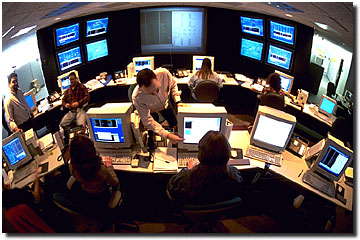 n 1962, the year of the Cuban missile crisis, the U.S. Air Force commissioned a study on how to build what Net historian Bruce Sterling describes as "a post-apocalypse command grid." A Rand Corporation researcher proposed a computer network with no central control point. The computers would have "redundancy of connectivity" -- they would automatically seek any combination of possible routes on the network to deliver messages from point A to point B. If one computer was vaporized in a nuclear blast, all the others could carry on unaffected.
n 1962, the year of the Cuban missile crisis, the U.S. Air Force commissioned a study on how to build what Net historian Bruce Sterling describes as "a post-apocalypse command grid." A Rand Corporation researcher proposed a computer network with no central control point. The computers would have "redundancy of connectivity" -- they would automatically seek any combination of possible routes on the network to deliver messages from point A to point B. If one computer was vaporized in a nuclear blast, all the others could carry on unaffected. Work on the network began informally in the mid-1960s. But it wasn't until September 1969 that the Defense Department's Advance Research Project Agency Network (ARPANet) began taking shape. Within two years, the network connected 17 points around the United States. The system was primitive -- a handful of switching computers with tiny memories hooked up to dinosaur mainframes, the whole mess connected by glacially slow modems. But ARPANet did what it was designed to do: send brief digital messages to any computer on the network. This was revolutionary. For the first time, computers thousands of miles from each other could share text and other data. As the network expanded, the first online communities started to form.
Even as the first ARPANet machines were connected, user demand created pressure for expansion and new services. In 1972, the challenge of connecting the embryonic U.S. network to computers overseas led to the InterNetwork Working Group and, eventually, to the Internet, which now counts about 7 million linked systems. In 1979, civilian researchers who had been shut out of ARPANet invented Usenet, a semiprivate grid that has mushroomed into a worldwide commons with 16,000 discussion groups. Phenomena the military planners never conceived -- America Online, the World Wide Web, Wired magazine, cyberporn, and the biggest wave of self-publishing in history -- followed.
The apocalypse that military planners feared never came. But by fostering the Internet, they touched off an explosion of a completely different nature. And as the smoke continues to clear, our ability to predict where this technology is leading is no better than that of the Net's founders.





